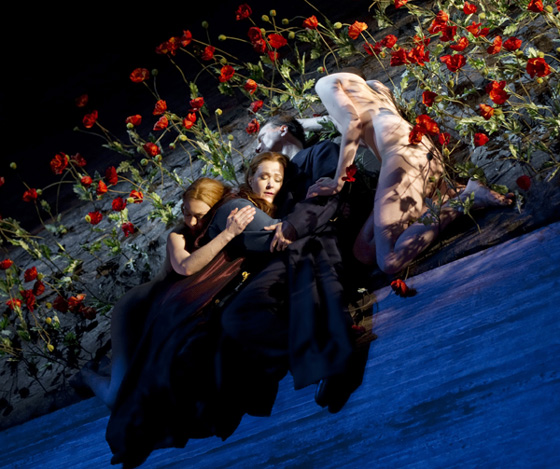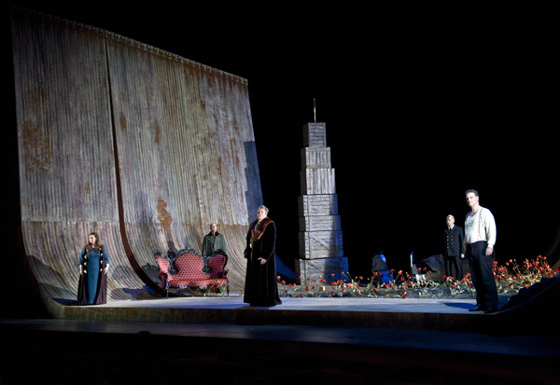 Norway Wagner, Tristan und Isolde: Soloists, Oslo Opera Orchestra, John Helmer Fiore (conductor), Oslo Opera, 18.3.2012 (JFL)
Norway Wagner, Tristan und Isolde: Soloists, Oslo Opera Orchestra, John Helmer Fiore (conductor), Oslo Opera, 18.3.2012 (JFL)
Production: Oslo Opera
Direction: Daniel Slater
Sets and Costumes: Robert Innes Hopkins
Lighting: Simon Mills
Cast:
Tristan: Robert Gambill
Isolde: Karen Foster
Marke: Magne Fremmerlid
Kurwenal: Ole Jørgen
Brangäne: Tuija Knihtilä
Melot: Attila Jun
Shepherd: Brenden Gunnell
Steersman: Jens-Erik Aasbø

You can’t blame the Oslo Opera that Tristan has only found its way into its program twice since the war—the mood for Wagner was likely limited after occupation, despite a bit of company-history with Tristan, seeing that Kirsten Flagstad made her Isolde debut on the stage of the Nationaltheateret in 1932. Wagner’s love story is back now, in the glorious new opera house, as part of the laudable attempt to groom the company to match the world class of its physical exterior.
John Helmer Fiore and the orchestra did their part to that effect: Him brimming with joy in the pit; his dedicated Opera Orchestra providing a clean reading, in neutral territory somewhere between grand romantic sweep and Italianate flow; well north of competent, slightly south of outstanding. (If you can hear the noise a muted TV makes, you might have been distracted by the persistent ~17kHz signal coming from the conductor monitors which I found distinctly distracting for the first time in this house.)
The principals made for a good show, too: Karen Foster’s Isolde acting is restricted by lack of agility and incomprehensible German. But her vocal determination and force make more than up for it. Robert Gambill’s Tristan went the other way about it: His voice was sometimes strained—as the rôle is wont to do to tenors—but his pronunciation and diction were pure joy. Ole Jørgen Kristiansen, the only other cast-member with good German, waited until the third act for his Kurwenal to really make an impression, but he certainly made one then; with clarity and power that, so late in the opera, can be short in supply. The off-stage performances of Brenden Gunnell (shepherd) and Jens-Erik Aasbø (steersman) were notably pleasant.
Another notch in the “Mission Excellence” tally came courtesy of Robert Innes Hopkins’s neither modern nor old fashioned sets and Simon Mills’ fine lighting. A large suspended lamp swings violently from left to right as a ship rolls and yawns in waving line with the overture. We’re in a seaborne field hospital hosting three beds in the bowels of the Cornwall-bound ship. The bow is full of shipping crates (Dowry-Я-Us); Tristan and Kurwenal sit in splendid isolation on the second level, doing nothing; maybe playing patience.

For the second act, the shell of the boat – widened – frames the stage. The crates are stacked to form a tower (a sword rakishly sticking out at the top, Excalibur-like). Through a crack stage-right, wild poppies eke out a widening patch reaching a wider opening stage-left. Breaking up further, the ship-elements on either side of the stage transform into towering cliffs for act three. The crates are now strewn about like skeletons spat out of permafrost graves and the dim light casts a dystopian shadow with glowing overtones of uranium green.
That’s as far as the good bits go, but there is the small matter of Daniel Slater’s direction and costumes by Robert Innes Hopkins, undoing some of the credit his sets deserve. He made Magne Fremmerlid’s King Marke look like something that fell off a Russian provincial theater’s truck; the costume combining maximum banality with a generous dash of ugly in huntsman-green (like Merry-Man Melot) to distinguish Team Marke from the vaguely naval dull-blue costumes of Team Tristan. Fremmerlid’s very low and nicely resonant voice, neither melodic nor agile, should make him well suited for Russian basso profundo roles but it wasn’t the stuff cut out for Wagner’s regal ruler.
During the overture, two naked lovers frolic about, cower to the side, get dressed and tucked in when the Vorspiel is over. Amid baffled gestures, standing, turning, and other time-kill gyrations, Brangäne (dour Tuija Knihtilä) works on the “balsam” from mother’s potion bags which are the IV bags next to the hospital beds. The death/love potion meanwhile consists of blood drawn from the arms of the beds’ occupants—the two lovers and a little boy. Tristan and Isolde fight for the syringe’s right to end their suffering. As the ship arrives at Cornwall, the fateful, but very much alive lovers movingly shrink from the light that shines on their illicit love through the opening crack in the hull.
The intimacy of the second act is difficult to stage, but setting it as two independent dramatic monologues, delivered to the ‘invisible audience’, standing about and wearily gesticulating, is the least satisfying option. We’re left with two hospital beds now and our lazy lovers from act one re-appear. They get busy soon – literally – and perform some surrogate copulation while the singers slow-dance in the background. Eventually all four of them fall into a pile of bodies from under which Isolde sings, with a scrotum dangling somewhere near her face: An awkward victory-huddle after the cup-clinching 1:0 for Nudists United. Kurwenal enters, gallivanting through the flowers with unintentional hilarity and a warning on his lips.
Oh, to have lived and seen the literal and metaphorical manifestation of “poppycock!”
Other questions remain unanswered upon first exposure to the production. Why does King Marke, the only one to actually sit on the literal flower bench, jointly stab Tristan (!) with Melot? The hospital bed countdown (now at one, reserved for ailing Tristan), makes sense at last. But why does our formerly naked girl, now in wallowing white, and pregnant, somnambulate by—minutes after Tristan’s references to his mother? Never mind. We’ll always have poppycock.
Jens F. Laurson